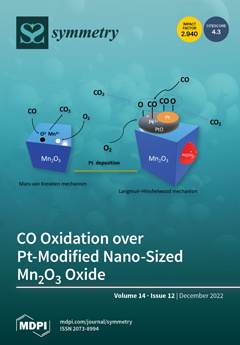Symmetry, Volume 14, Issue 12 (December 2022) – 222 articles
The deposition of platinum on the surface of nanosized Mn2O3 having cubic symmetry leads to the formation of finely divided PtO and Pt(OH)2. The CO adsorption in an inert atmosphere or in the presence of oxygen leads to a partial reduction in the Pt2+ surface species and the formation of linear Pt1+−CO and Pt0−CO carbonyls.
Based on the combination of experimental results and model calculations, it is concluded that the Mars–van Krevelen mechanism is the most probable over pure Mn2O3. The addition of platinum to Mn2O3 changes the reaction mechanism to the Langmuir–Hinshelwood type. Both linear carbonyls, formed on Pt1+ and Pt0 centers, took part in the reaction on the surface of Pt/Mn2O3. View this paper
- Issues are regarded as officially published after their release is announced to the table of contents alert mailing list.
- You may sign up for e-mail alerts to receive table of contents of newly released issues.
- PDF is the official format for papers published in both, html and pdf forms. To view the papers in pdf format, click on the "PDF Full-text" link, and use the free Adobe Reader to open them.





